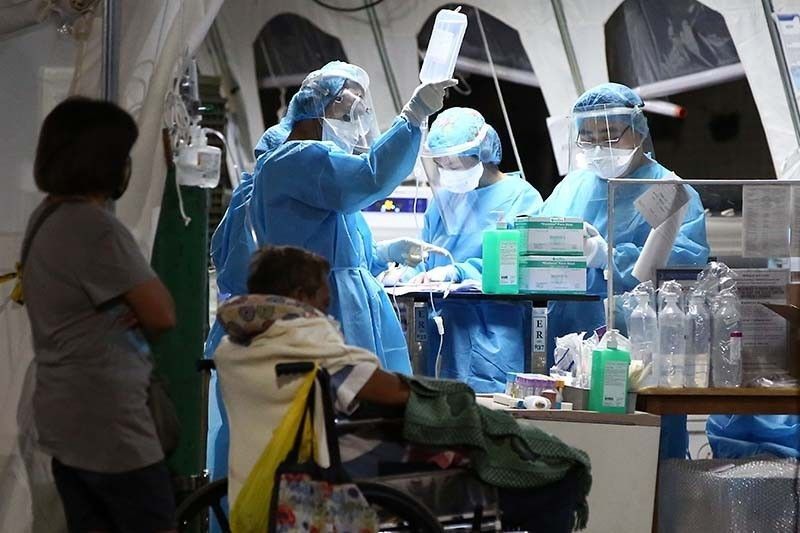‘Cebu COVID woes also possible in Metro Manila’

MANILA, Philippines — Metro Manila could experience a surge of coronavirus disease 2019 (COVID-19) cases that could be worse than the current situation in Cebu City, experts from the University of the Philippines have warned.
Professor Ranjit Singh Rye, who is part of the team that correctly projected the total number of cases in the country by June 15, said people are becoming less disciplined in practicing safety measures against the virus.
“The curve was flattening, but we are not seeing the other side of the curve. Can Cebu happen in Manila? Of course, which is why we also recommended to put all options on the table,” Rye told “The Chiefs” on One News / TV5 on Tuesday night.
“If it happened in Cebu, it could also happen in Metro Manila. It could be worse here,” he added, noting the dense population of the National Capital Region (NCR).
In May, the UP team – led by Rye, mathematics professor Guido David and researcher Ma. Patricia Agbulos – projected the number of COVID-19 cases in the country to reach 24,000 by June 15.
The projected figure was reached on June 11, with the cases further rising to 27,238 as of yesterday.
On Monday, the Inter-Agency Task Force on Emerging Infectious Diseases reverted Cebu City to enhanced community quarantine (ECQ), the strictest lockdown scenario, due to the rising cases in the past weeks.
Official data from the Department of Health (DOH) showed that there are 2,905 cases and 35 deaths in Cebu City as of Tuesday. More than 500 cases were recorded in the past 14 days, or after the city was placed under general community quarantine (GCQ) on June 1.
Data from the Cebu City Health Department showed higher figures, with 3,814 cases and 203 deaths. There are 1,851 active cases.
Rye said Cebu City is an instructive case, noting their previous recommendation that it is premature to lower its quarantine status because transmissions are still high and there is no successive weeks of decline.
He warned the government not to overestimate its achievements in controlling the spread of the disease, stressing that the virus remains a clear and present danger to all.
The latest forecast released by the UP team categorized the entire Cebu province as a high-risk area, projecting 11,000 cases and 90 deaths by June 30 if the trend continues, based on DOH data.
In Metro Manila, the report projected up to 20,500 cases and 1,200 deaths by June 30.
If the trend is maintained, it warned that the number of total cases nationwide could increase to 40,000 by the end of the month.
“To this end, we recommend that the government review its strategies for social distancing and other health protocols in Metro Manila and Cebu,” the report dated June 11 read.
“The easing of quarantine restrictions must be matched with tighter monitoring, stricter social distancing and wearing of (face masks and other protective equipment) and increased testing and surveillance as the working population begins to increase their exposure,” it added.
Uncategorized cases
During the program, Rye and David also raised concern over the thousands of uncategorized cases, or those whose locations are not identified.
DOH data showed that 2,659 cases are classified as coming from unknown regions as of Tuesday, many of them recorded this month.
“This is a key issue in DOH. The data is becoming problematic as time passes,” Rye said. “Imagine you want to study Cebu, you want to study the NCR, how can you make a model now? You can’t guess where these cases are located.”
Beyond forecasts, Rye said the location data is very significant as it would have an impact on the strategies implemented on the ground.
Asked about the reason for these uncategorized cases, the UP professor cited the DOH explanation that some laboratories are not filling up the proper information on those they test.
“We can encourage and exhort our laboratories to be more accurate in transmitting data. It’s also important for local government units to submit validated and cleaned up data to the DOH in a timely manner,” he said.
‘MM nearly reverted to MECQ’
Metro Manila, which accounts for about half of the country’s COVID-19 cases, nearly reverted to a stricter quarantine scenario, Malacañang revealed yesterday.
The country’s capital region, home to more than 12 million people, will remain under the more lenient GCQ until June 30 despite the rising number of people who had caught the virus.
The government, however, tightened the quarantine measures in Cebu City, which has reverted to the strictest ECQ and nearby Talisay City, which is now under modified ECQ.
Presidential spokesman Harry Roque said Metro Manila almost joined the fate of the two areas now under more stringent community quarantine.
“Metro Manila was even ‘pasang-awa (borderline passing)’ for GCQ. To qualify for GCQ or moderate risk, you need to have a case doubling rate of seven (days); Metro Manila’s case doubling rate is 6.9,” Roque told ABS-CBN News Channel.
“So, if we were strict about it, Metro Manila would have been back to modified ECQ. But 6.9 is, you know, almost seven and that’s why we classified (Metro Manila under) GCQ,” he added.
Only indispensable services like health care, agriculture, food distribution, export-oriented business and business process outsourcing are allowed under ECQ. When an area shifts to MECQ, selected industries can partially resume operations but all modes of public transportation remain suspended.
Restrictions in some modes of public transport and a majority of industries are lifted in GCQ areas but leisure activities and tourism remain suspended and public gatherings still limited.
Under the most lenient MGCQ, all establishments and some forms of mass transportation may resume operations but cannot fully operate to ensure safe distancing. Public events are also permitted but only up to half of the venue may be filled.
Roque said what made Metro Manila different from Cebu City is the availability of health facilities that can serve people who will get sick.
“One thing going for Metro Manila, though, which is not going for Cebu City is that we have substantial critical care capacity. Our occupancy rate for our critical care wards as well as isolation facilities is only at around 30 to 40 percent, so we have about 60 to 70 percent capacity still,” the Palace spokesman said.
“Cebu City, on the other hand, had a case doubling rate of 6.6 (days) and then it had already 100 percent capacity for (intensive care unit) beds and 93 percent capacity for its isolation facilities which is now classified as dangerous. And that’s why Cebu became an ECQ and Metro Manila retained its classification of GCQ,” he added.
Roque said the case doubling rate and critical care capacity determine the quarantine classification of an area.
Aside from Metro Manila, other areas under GCQ until the end of the month are Isabela, Nueva Vizcaya, Quirino and Santiago City in Cagayan Valley; Aurora, Bataan, Bulacan, Olongapo, Tarlac in Central Luzon; Cavite, Laguna, Batangas, Rizal and Quezon in Calabarzon; Occidental Mindoro in Mimaropa, all in Luzon; Bohol, Cebu province, Negros Oriental, Siquijor, Mandaue City and Lapu-Lapu City in the Visayas and Davao City and Zamboanga City in Mindanao.
The rest of the country have been placed under the most relaxed MGCQ as the government strives to gradually reopen the economy while containing the virus. Alexis Romero, Sheila Crisostomo, Delon Porcalla
- Latest
- Trending





























